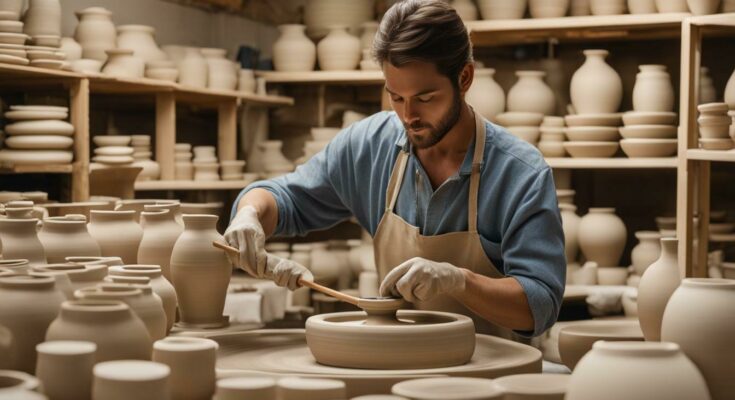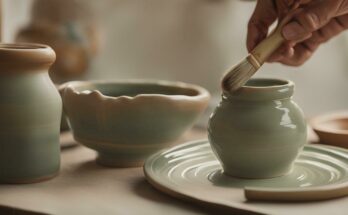Glazing pottery without heat may seem like a daunting task, but it can be a rewarding and fun experience for beginners and experts alike. Whether you don’t have access to a kiln or you simply want to try a different technique, glazing without heat offers a variety of creative possibilities.
However, it’s important to note that glazing without heat requires proper techniques and careful attention to detail. Without the proper approach, your pottery may not reach its full potential. In this article, we’ll explore various methods and techniques for glazing pottery without heat, and provide tips and tricks to help you achieve stunning results.
Key Takeaways:
- Glazing pottery without heat is a fun and creative alternative to traditional methods.
- Proper technique and attention to detail are crucial for success.
- This article will provide step-by-step instructions and expert tips for various glazing methods without heat.
Alternative Ways to Glaze Pottery
Glazing pottery without heat is not only possible but can also be a fun and creative way to achieve unique and stunning effects on your ceramics. Here are some alternative ways to glaze pottery without using a kiln:
Brush-on Glazes
Brush-on glazes are a popular way to add color and texture to pottery. To apply brush-on glazes, you will need a variety of brushes of different sizes, and a clean and prepped surface to work on. Begin by stirring the glaze thoroughly, then use a brush to apply glaze in thin and even coats. Allow the glaze to dry completely before applying additional coats or firing the pottery.
Spray-on Glazes
Spray-on glazes are another option for glazing pottery without heat. You can use an airbrush or a spray can to apply the glaze in a fine mist onto your pottery. This method gives a smooth, even finish and is ideal for covering large or complex surfaces. You will need to make sure that the glaze is evenly distributed and that the surface is properly prepped before applying the glaze.
Slip Glazing
Slip glazing is a technique in which liquid clay is applied to the surface of pottery in thin layers. Slip glazing can create a wide range of textures and finishes, including glossy, matte, and textured surfaces. To apply slip glaze, you will need to mix the clay to a runny consistency, then use a brush or a spray bottle to apply it onto your pottery. Allow the slip glaze to dry completely before firing the pottery.
These are just a few of the many ways to glaze pottery without heat. With a bit of experimentation and practice, you can discover your own unique methods and techniques for achieving beautiful and creative effects on your ceramics.
Non-Fired Pottery Glaze: Exploring Your Options
When it comes to pottery glaze without firing, there are several options available that can produce beautiful results.
Air-Dry Glazes
Air-dry glazes are popular for their ease of use and convenience. These glazes can be applied directly to bisqueware and do not require any additional heat to cure. However, they may not provide the same level of durability and hardness as fired glazes.
Acrylic Glazes
Acrylic glazes are perfect for use on non-porous surfaces such as glass or plastic. They dry quickly and have a glossy finish, but may not provide the same level of depth and complexity as traditional fired glazes.
Cold Finishes
Cold finishes refer to a variety of coatings and sealants that can be used to protect and enhance pottery surfaces. These may include wax, varnish, or polyurethane. While they do not require any additional heat, they may need to be reapplied periodically to maintain their appearance and durability.
When using non-fired pottery glazes, it’s important to choose the right product for your specific project and to follow the manufacturer’s instructions carefully.
Heat-Free Pottery Glazing Methods
Glazing pottery without heat is an incredible way to achieve unique and stunning effects that cannot be produced in a kiln. Here are some heat-free pottery glazing methods:
Wax Resist
Wax resist is a method of preventing glaze from adhering to certain areas of a piece. This technique involves applying wax to areas that you wish to remain unglazed. After applying wax, the piece is then glazed. The waxed areas will repel the glaze and remain unglazed. Once the glaze has dried, the wax can be removed by gently rubbing the piece with a soft cloth.
Burnishing
Burnishing involves using a smooth object, such as a spoon or a smooth stone, to compress and polish the surface of the clay. This process creates a shiny, polished surface that does not require glaze. Burnishing can be done at any stage of pottery making, even on greenware. You can use tools like metal spoons, smooth stones, or terra cotta burnishing tools.
Raku Glazing
Raku glazing is a Japanese technique which involves removing a piece from the kiln at high temperature and immediately placing it into a combustible material, such as sawdust or newspaper. The piece is then covered with the material and allowed to smoke. This process creates unique and unpredictable surface effects that cannot be replicated with traditional kiln firing.
Using these heat-free pottery glazing methods can open up a world of creative possibilities. With practice and experimentation, you can achieve stunning and unique results that will make your pottery stand out.
Learn How to Glaze Pottery Without a Kiln – Easy Steps Guide
Glazing Ceramics Without Heat: Tips and Tricks
While glazing pottery without heat is a fun and unique way to explore your creativity, it also requires proper technique to achieve desired results. Here are some tips and tricks to help you master the art of pottery glazing without a kiln.
Consider the Glaze Type
When selecting a glaze, it is important to choose one that is suitable for heat-free glazing. Some types of glazes can only be fired in a kiln, so be sure to read the instructions carefully before starting. You can also experiment with different types of glazes, such as brush-on, spray-on, and slip glazes, to achieve different effects.
Prepare the Surface
Proper surface preparation is key to successful glazing without heat. Make sure the pottery piece is clean and dry before applying the glaze. If the surface is too glossy or smooth, it may be helpful to lightly sand it with fine-grit sandpaper to create a better surface for the glaze to adhere to.
Apply the Glaze Carefully
When applying the glaze, be sure to follow the instructions carefully. Some glazes may require multiple coats, while others may need to be applied in a specific order. Use a soft-bristle brush or spray bottle to apply the glaze evenly, and avoid over-applying, as this can cause drips and uneven coverage.
Troubleshoot Common Issues
Even with proper technique, issues may arise during the glazing process. If you notice the glaze is cracking or peeling, it may be due to improper surface preparation or application. If the glaze appears cloudy or dull, it may be because the glaze was not properly mixed before application. If you encounter any issues, don’t be afraid to experiment and try different techniques until you achieve your desired results.
By following these tips and tricks, you can successfully glaze ceramics without heat and enjoy the unique creative possibilities this technique offers.
Conclusion
Glazing pottery without heat can be a challenging yet rewarding process. By mastering the various techniques and methods available, you can achieve unique and stunning results that showcase your creativity and skill.
Remember that practice and experimentation are key to successful glazing without a kiln. Take the time to explore different types of glazes and techniques, and don’t be afraid to try new things.
Proper preparation and technique are also essential for achieving the desired results. Take care to properly clean and prepare the surface of your pottery, and follow the specific instructions for each glaze or method you use.
Keep in mind
If you encounter issues during the glazing process, don’t be discouraged. Remember that every artist experiences setbacks and challenges, and that these can often lead to new discoveries and creative breakthroughs.
With patience, persistence, and a willingness to learn, you can master the art of glazing pottery without heat and create unique and beautiful works of art.
FAQ
Q: What is glazing pottery without heat?
A: Glazing pottery without heat refers to the process of applying a glaze to ceramic ware without using a kiln or any other heat source to set the glaze.
Q: Why would someone choose to glaze pottery without heat?
A: Glazing pottery without heat allows artists and pottery enthusiasts to create ceramic pieces without the need for specialized equipment. It can be a more accessible and cost-effective way to glaze pottery.
Q: What are some alternative ways to glaze pottery without heat?
A: Some alternative ways to glaze pottery without heat include brush-on glazes, spray-on glazes, and slip glazing. Each technique offers different advantages and can produce unique results.
Q: Are there non-fired pottery glazes available?
A: Yes, there are non-fired pottery glazes available, such as air-dry glazes, acrylic glazes, and cold finishes. These glazes can provide a similar appearance to traditional fired glazes without the need for heat.
Q: What are some heat-free pottery glazing methods?
A: Some heat-free pottery glazing methods include wax resist, burnishing, and raku glazing. These techniques can create interesting texture and color effects on ceramic surfaces.
Q: What tips and tricks can help with glazing ceramics without heat?
A: When glazing ceramics without heat, it’s important to consider factors such as glaze selection, surface preparation, and troubleshooting common issues. Practice, experimentation, and proper technique are key to successful glazing without heat.



